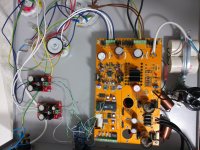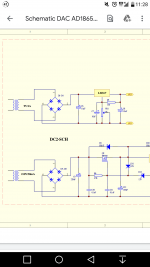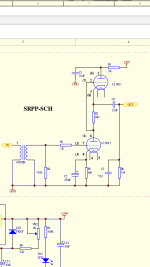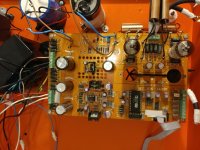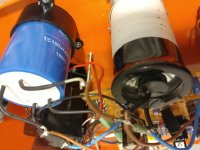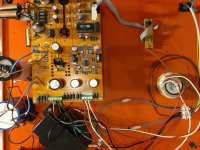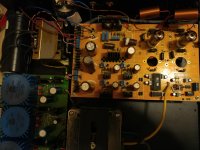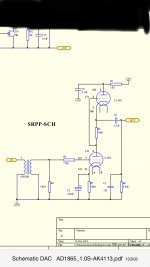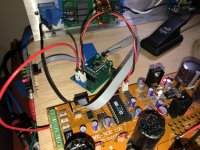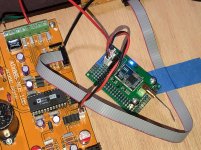Hello,
I have some problem with a DAC, the 100Hz hum (AC - 50Hz)... unfortunately I don't have an oscilloscope to hunt it properly, so I tried to change something, but before making other steps I told myself that it may be better to ask some advice.
Last year I built a DAC for a friend using a platform bought from ebay. Some upgrades on the digital part (Silmic as filter capacitors, better opamp) and for SRPP - AMRG resistors in SRPP, Audyn True Copper as anode filter capacitor, Duelund CuSn 0.47uF - output, 470uF Silmic at cathodes, Tepro RA I/V. Without interstage transformers. Anode PSU build using onboard rectifier, but changed the onboard stabilization with a simple CRC (66uF Mundorf MKP - 3K Mills - 10uF Obbligato). With SPDIF initially, but he wanted to use only USB after a while so I changed SPDIF for an USB board from JLSouns with signal directly to AD1865 (photo 1). For heaters I used the onboard rectifier with 1500uF Panasonic FC - LM317 - 470uF Cerafine with 6.2VDC at each tube. The original schematic is attached (photo 2 Heaters PSU and Photo 3 - SRPP). In SRPP, all optional parts were not installed.
I build for me the same DAC (with some changes on board - 220uF Silmic at cathodes, Vishay Naked I/V resistors, Miflex CopperFoil bypassed with 0.01uF Duelund CuSn output). First PSU for anodes was made with tube rectifier and simple CRC after it - 10uF - 3k Mills - 10uF (both capacitors Obligato Film Oil). For heaters I used onboard rectifier, with 4700uF Nichicon first cap and 1000uF Silmic second Cap. Instead of the 1K variable resistor from the schematic attached, there is one 80R resistor. When I put it to play, 100Hz hum. Sound without distortion, clear, all OK as sound, but with that hum, amplified by the amplifier. Increasing the volume, increased the hum also, but only on quiet passages you hear it. It never covers the music. With no SPDIF signal, hum present. Only when removing ECC88 the hum disappears. Tried different ECC88 with no better result.
I thought it is from poor filtering of anode. Replaced the resistor in CRC and put there a choke. Increased the first cap to 50uF. The hum is still there. Switched to onboard rectifier instead of the 5AR4 one, increased the first cap capacitance to 100uF (ClarityCap TC you may see in last pictures). Changed the transformer also to have the new desired AC connections. The hum is still there.
So probably it is from the heaters (!?). There is 6.1VDC there, new parts... I thought about changing the three capacitors in the PSU, especially the small Sanyo OsCon (10uF) close to the LM... but I decided to write here for help!
If you have any idea, please!
Thanks!
I have some problem with a DAC, the 100Hz hum (AC - 50Hz)... unfortunately I don't have an oscilloscope to hunt it properly, so I tried to change something, but before making other steps I told myself that it may be better to ask some advice.
Last year I built a DAC for a friend using a platform bought from ebay. Some upgrades on the digital part (Silmic as filter capacitors, better opamp) and for SRPP - AMRG resistors in SRPP, Audyn True Copper as anode filter capacitor, Duelund CuSn 0.47uF - output, 470uF Silmic at cathodes, Tepro RA I/V. Without interstage transformers. Anode PSU build using onboard rectifier, but changed the onboard stabilization with a simple CRC (66uF Mundorf MKP - 3K Mills - 10uF Obbligato). With SPDIF initially, but he wanted to use only USB after a while so I changed SPDIF for an USB board from JLSouns with signal directly to AD1865 (photo 1). For heaters I used the onboard rectifier with 1500uF Panasonic FC - LM317 - 470uF Cerafine with 6.2VDC at each tube. The original schematic is attached (photo 2 Heaters PSU and Photo 3 - SRPP). In SRPP, all optional parts were not installed.
I build for me the same DAC (with some changes on board - 220uF Silmic at cathodes, Vishay Naked I/V resistors, Miflex CopperFoil bypassed with 0.01uF Duelund CuSn output). First PSU for anodes was made with tube rectifier and simple CRC after it - 10uF - 3k Mills - 10uF (both capacitors Obligato Film Oil). For heaters I used onboard rectifier, with 4700uF Nichicon first cap and 1000uF Silmic second Cap. Instead of the 1K variable resistor from the schematic attached, there is one 80R resistor. When I put it to play, 100Hz hum. Sound without distortion, clear, all OK as sound, but with that hum, amplified by the amplifier. Increasing the volume, increased the hum also, but only on quiet passages you hear it. It never covers the music. With no SPDIF signal, hum present. Only when removing ECC88 the hum disappears. Tried different ECC88 with no better result.
I thought it is from poor filtering of anode. Replaced the resistor in CRC and put there a choke. Increased the first cap to 50uF. The hum is still there. Switched to onboard rectifier instead of the 5AR4 one, increased the first cap capacitance to 100uF (ClarityCap TC you may see in last pictures). Changed the transformer also to have the new desired AC connections. The hum is still there.
So probably it is from the heaters (!?). There is 6.1VDC there, new parts... I thought about changing the three capacitors in the PSU, especially the small Sanyo OsCon (10uF) close to the LM... but I decided to write here for help!
If you have any idea, please!
Thanks!
Attachments
Last edited:
R4 is shorted. From IV resistor (before the transformer in the schematic, also not used in the dac) the signal goes through 1k resistor to grid.
strange thing is that in the same platform, same components mostly, all DC voltages OK at every point and, still, this one has this horrible hum.
there is no volume control - the hum is amplified by the integrated amplifier (EL84 SE, home made, point to point, AMRG, Duelund etc.)
strange thing is that in the same platform, same components mostly, all DC voltages OK at every point and, still, this one has this horrible hum.
there is no volume control - the hum is amplified by the integrated amplifier (EL84 SE, home made, point to point, AMRG, Duelund etc.)
the power supply is regulated with LM317 just for the filaments. where the first cap is a Nichicon 4700uF then LM with two 80r resistors (r5 -with 10uF Oscon- and vr1) and second cap, 1000uF Silmic.
210v schematic is not the one in the picture.
for anode is a simple CLCRC: 160VAC - solid state rectifier -100uF ClarityCap (Kelvin leads), 20H50ma - 10uF Obbligato (caps are outside the board, but connected to the board with wires) - 2k AMRG - 0.22 Audyn True Copper. firs PSU for anode was tube (gz34) rectified and with another transformer, the hum was there so I changed the PSU (first part - rectifier and CLC; RC is the same) thinking it might be from there. but the hum remained.
210v schematic is not the one in the picture.
for anode is a simple CLCRC: 160VAC - solid state rectifier -100uF ClarityCap (Kelvin leads), 20H50ma - 10uF Obbligato (caps are outside the board, but connected to the board with wires) - 2k AMRG - 0.22 Audyn True Copper. firs PSU for anode was tube (gz34) rectified and with another transformer, the hum was there so I changed the PSU (first part - rectifier and CLC; RC is the same) thinking it might be from there. but the hum remained.
Hello,
I have some problem with a DAC, the 100Hz hum (AC - 50Hz)... unfortunately I don't have an oscilloscope to hunt it properly, so I tried to change something, but before making other steps I told myself that it may be better to ask some advice. ......Thanks!
Hello Gionloc,
Wow! A friend of mine just alerted me of this thread because I’m working on the same exact Dac board. Good timing
Ok, the dreaded 60Hz hum was present on my setup also, I tried all the grounding tips and tricks in my diya tool bag. Nothing worked, the constant hum was still audible 6 feet away from my speakers. I figured the onboard filament heater psu, which draws the highest current is the culprit. So I bypassed it and used a dedicated off-board heater psu. This psu uses a Micrel LDO regulator which enables the use of the 6.3vac secondary to get 6.3vdc.
I’m using two transformers, R-Core 0v-9v(X2) secondaries and an
Antek AS-05T240 for the HV and filament heater.
The two trafo shield wires, heater psu ground wire and earth ground all connect at a single point, then a CL60 NTC connects that point to the Dac board ‘GND’ input.
This setup cured the hum issue!! Extremely quiet now, with my ear right up to the speaker I can barely hear anything.
I also changed out a bunch of questionable looking parts. I got a good laugh when I saw the trimpot brand: Bochen
These changes really improved the sound now compared to when it was first powered up.
Attachments
-
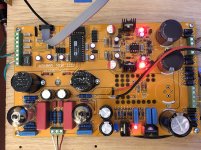 8C30809F-68F2-43B2-BCE0-42A3752EC229.jpg1,022.2 KB · Views: 90
8C30809F-68F2-43B2-BCE0-42A3752EC229.jpg1,022.2 KB · Views: 90 -
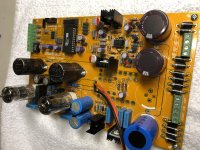 1CD8985C-0230-4EF8-AFC4-0B6420775303.jpg993.7 KB · Views: 74
1CD8985C-0230-4EF8-AFC4-0B6420775303.jpg993.7 KB · Views: 74 -
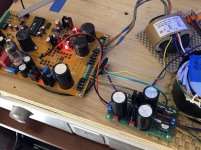 E6555B86-DBA6-4BDD-BB11-990838E5B69E.jpg1,007.5 KB · Views: 70
E6555B86-DBA6-4BDD-BB11-990838E5B69E.jpg1,007.5 KB · Views: 70 -
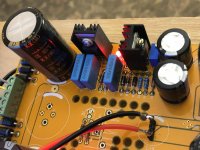 F9667D5A-CD0D-46C1-9831-B3D7CC769B1C.jpg816.2 KB · Views: 83
F9667D5A-CD0D-46C1-9831-B3D7CC769B1C.jpg816.2 KB · Views: 83 -
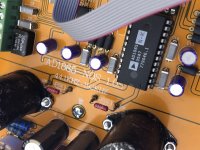 8AAED26D-F4D5-4A7B-BF8D-2F4E4808F718.jpg855.8 KB · Views: 54
8AAED26D-F4D5-4A7B-BF8D-2F4E4808F718.jpg855.8 KB · Views: 54
Hello Vunce and glad to see your work and results!
I thought that a solution is to try to change the filament supply, but first idea was to change the parts that are on the board - diodes (came with the board, nothing special as quality), capacitors (although they are all new and that I have 6.1VDC)... but your solution is better. I shall build an external regulated power supply for heaters and see the results.
for me it is the third time I use this board. first time was inside a CDPlayer that I still own, where I have a CDPro transport with signal directly to CS8414 (photo below) and the second one was used in friend's DAC mentioned in my first message here. CDP is also very good and was the basic platform for testing the board and looking for upgrades. and with this DAC is the first time that hum enters the room!
as IV resistor I use 220r, went down from 330r in steps. Audio Note tantalum changed to PRP - the sound was cleaner, better bass, better highs. then changed to Tepro RA, sounded pretty the same, no major difference. then to Vishay Naked, which are much better - definition is better, cleaner sound, more precision in musical images. when I'll see that 100Hz Hum out of the system, I'll like to try a 500-600r resistor there. I read it may sound more organic, natural when going over 500R,
best upgrades for the platform were - Amtrans AMRG resistors in SRPP (tried PRP, Audio Note and Kiwame - AMRG are the best by far! I also use them in amplifier(s), where possible.
CRC/CLC supply for anode was better in CDP then the board regulated one, so I kept this idea in next DACs.
one of the best upgrades was changing anode supply capacitor with Audyn True Copper (tested there Mundorf SilverOil, SilverGoldOil, Obbligato Gold and AmpOhm with poor results; Audyn is so good there, it is hard to believe!).
cathode bypass cap - tried Black Gate and Elna Silmic, Silmic remained.
One day, not far away, I would like to use the digital part of another board like this and build another tube output with one triode/channel (from a double triode, having one tube in dac for each channel, but only one triode wired), anode follower probably, 6n2p maybe, with AC filaments... we'll see. until then, I'll try to kill the hum!
I thought that a solution is to try to change the filament supply, but first idea was to change the parts that are on the board - diodes (came with the board, nothing special as quality), capacitors (although they are all new and that I have 6.1VDC)... but your solution is better. I shall build an external regulated power supply for heaters and see the results.
for me it is the third time I use this board. first time was inside a CDPlayer that I still own, where I have a CDPro transport with signal directly to CS8414 (photo below) and the second one was used in friend's DAC mentioned in my first message here. CDP is also very good and was the basic platform for testing the board and looking for upgrades. and with this DAC is the first time that hum enters the room!
as IV resistor I use 220r, went down from 330r in steps. Audio Note tantalum changed to PRP - the sound was cleaner, better bass, better highs. then changed to Tepro RA, sounded pretty the same, no major difference. then to Vishay Naked, which are much better - definition is better, cleaner sound, more precision in musical images. when I'll see that 100Hz Hum out of the system, I'll like to try a 500-600r resistor there. I read it may sound more organic, natural when going over 500R,
best upgrades for the platform were - Amtrans AMRG resistors in SRPP (tried PRP, Audio Note and Kiwame - AMRG are the best by far! I also use them in amplifier(s), where possible.
CRC/CLC supply for anode was better in CDP then the board regulated one, so I kept this idea in next DACs.
one of the best upgrades was changing anode supply capacitor with Audyn True Copper (tested there Mundorf SilverOil, SilverGoldOil, Obbligato Gold and AmpOhm with poor results; Audyn is so good there, it is hard to believe!).
cathode bypass cap - tried Black Gate and Elna Silmic, Silmic remained.
One day, not far away, I would like to use the digital part of another board like this and build another tube output with one triode/channel (from a double triode, having one tube in dac for each channel, but only one triode wired), anode follower probably, 6n2p maybe, with AC filaments... we'll see. until then, I'll try to kill the hum!
Attachments
and also - the dac build for my friend, the sound from JL Sound USB (with dedicated PSU for oscillators and for clock, so you have only signal from USB PC) driving AD1865 was extremely good, from memory seems better than SPDIF (although I'll see them face to face just after resolving hum problem on mine; and his dac has Duelund CuSn output capacitors, mine has MiflexCopper bypassed with Duelund CuSn).
for me, and USB only DAC is not an option, I have a larce CD collection and I also use bluray, so SPDIF is a more flexible option for me. but for PC-streaming use, USB direct drive is the option!
for me, and USB only DAC is not an option, I have a larce CD collection and I also use bluray, so SPDIF is a more flexible option for me. but for PC-streaming use, USB direct drive is the option!
Vunce,
I would say that you may go straight to Amtrans AMRG for SRPP, and 0.1-0.22uF anode capacitor, you would like the result!
hallcon83 - here is the link but no offer right now:
DAC AD1865 1.0S NOS coupling transformer SRPP output 192KHz | eBay
I would say that you may go straight to Amtrans AMRG for SRPP, and 0.1-0.22uF anode capacitor, you would like the result!
hallcon83 - here is the link but no offer right now:
DAC AD1865 1.0S NOS coupling transformer SRPP output 192KHz | eBay
Vunce,
I would say that you may go straight to Amtrans AMRG for SRPP, and 0.1-0.22uF anode capacitor, you would like the result!
Hi Gionloc,
The component values on my schematic differ slightly from yours, I don’t know why, they are the same circuit?
The stock resistor values installed in the SRPP section on my board are not what’s on the schematic either:
R1 - 2K2
R2 - 1K
R3 - 47R
R4 - 3K9
R5 - 1K
R6 - 100K
I have some some film caps on hand for the anode capacitor (C5) I can try out.
Attachments
Hi Gionloc,
The component values on my schematic differ slightly from yours, I don’t know why, they are the same circuit?
The stock resistor values installed in the SRPP section on my board are not what’s on the schematic either:
R1 - 2K2
R2 - 1K
R3 - 47R
R4 - 3K9
R5 - 1K
R6 - 100K
I have some some film caps on hand for the anode capacitor (C5) I can try out.
the idea of transformer end is to achieve galvanic isolation after DA section and pure analog stage after IV conversion?
So disconnect the ground between primary and secondary. I presume that tube gain stage have own power supply without sharing ground tap with other PS...
...
With that same ground line (even with transformer in the path) You have noise from digital source and DAC present.
....With that same ground line (even with transformer in the path) You have noise from digital source and DAC present.
Hi Zoran,
My board had a hum when the on-board filament heater psu was used. Once that was bypassed and an off-board dedicated heater psu was used this board is totally silent, no hum at all.
I’ve since added a BT 5.0 SPDIF output module. I soldered a Molex header on the +5/GND pads to power it. Works very well!
Attachments
Hi Zoran,
My board had a hum when the on-board filament heater psu was used. Once that was bypassed and an off-board dedicated heater psu was used this board is totally silent, no hum at all.
I’ve since added a BT 5.0 SPDIF output module. I soldered a Molex header on the +5/GND pads to power it. Works very well!
Hi Vice
I understood that You solve hum issue with other heating power supply. I just want to say that this ground connection from primary to secondary at the interstage transformer not making the galvanic isolation.
.
If You have separate power supply for High voltage, and I guess it is the case, then You can disconnect this connection. And have full galvanic isolation from DA side to pure Analog side.
- Status
- This old topic is closed. If you want to reopen this topic, contact a moderator using the "Report Post" button.
- Home
- Source & Line
- Digital Line Level
- 100Hz Hum Problem DAC SRPP ECC88 output
